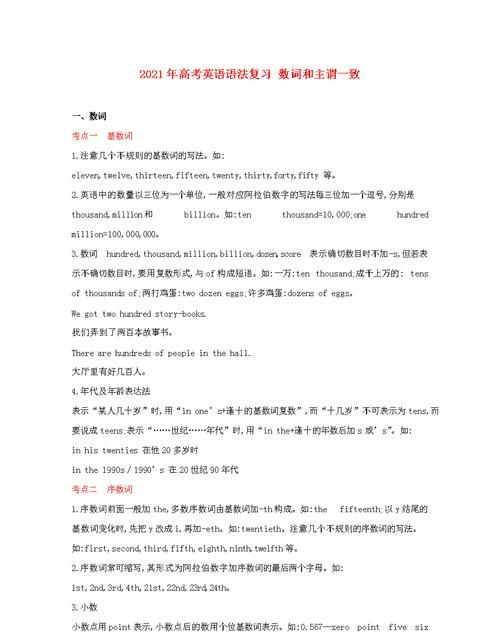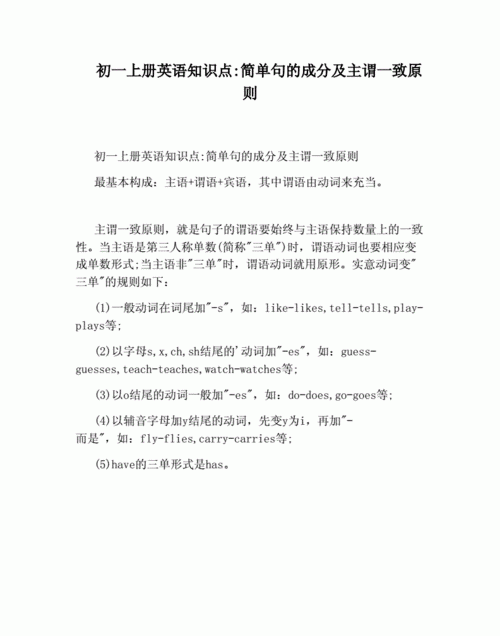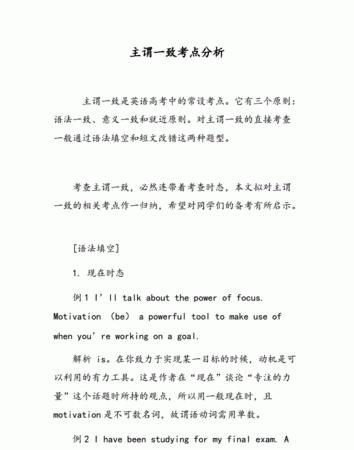本文目录
关于主谓一致的题目及答案
主谓一致有许多原则,概括起来不外乎三种一致原则,即:语法形式一致;概念一致(语言内容上一致);毗邻一致(谓语动词的单复数形式和紧位于其前的主语一致)。
另外,根据代词应该在人称、数、性等方面与所指的词保持一致,还有指代一致。
一、语法形式一致
1、单数主语、单个动词不定式、动名词短语以及句子作主语,谓语动词要用单数形式。复数主语,用and或both…and连接的动词不定式短语、动名词短语以及主语从句作主语,谓语动词则用复数形式。例如:
Serving the people is my great happiness. 为人民服务是我最大的幸福。
Whether we’ll go depends on the weather. 我们是否去要取决于天气的好赖。
What I think and what I seek have been fairly reflected in my paper.
我所思考的和我所寻求的都在这个论文中体现了出来。
2、由as well as, with, along with, like, together with, rather than, except, but, including, accompanied by, plus, besides, in addition to, no less than 等引起的结构跟在主语后面,不能看作是并列主语,该主语不受这些词组引导的插入语的影响,主语如是单数,其谓语动词仍然用单数形式。例如:
The reading course book, plus its reference books, is helpful to college students.
教材加上参考书对大学学生是非常有益的。
The man together with his wife and children sits on the sofa watching TV.
那个人和他妻儿老小坐在沙发上看电视。
3、有些代词只能指单数可数名词,当它们在句子中作主语时,尽管在意义上是多数,谓语动词仍要用单数形式。这类代词有either, neither, each, one, the other, another, somebody, someone, something, anyone, anything, anybody, everyone, everything, everybody, no one, nothing, nobody等。例如:
Neither likes the friends of the other. 两人都不喜欢对方的朋友。
Everything around us is matter. 我们周围的所有东西都是物质。
4、当and连结的两个名词是指同一个人或同一件事,and后的名词前没有冠词,谓语动词应该用单数形式;在and后面的名词前有冠词,谓语就用复数形式。例如:
The bread and butter is served for breakfast. 早饭供应黄油面包。
The bread and the butter are on sale. 正在出售黄油和面包。
5、当one of, a portion of, a series of, a species of, a chain of 结构作主语时,谓语动词要用单数形式。例如:
One of those students has passed the examination. 这些学生只有一个考试及格了。
A series of pre-recorded tapes has been prepared for language laboratory use.
为语音课提前准备了一系列录音磁带。
6、由one and a half + 复数名词或the majority of + 名词作作主语时,谓语动词视名词的单复数形式而定。例如:
The majority of the damage is easy to repair. 大部分的损坏品都容易修理。
7、plenty of, half of, a lot of, lots of, heaps of, loads of, scads of等 + 可数与不可数名词作主语时,不可数名词的谓语只用单数,可数名词的谓语视可数名词的单复数而定。例如:
There is plenty of water in the pail. 桶里还有好多水。
There are plenty of eggs in the box. 箱子里有好多鸡蛋。
8、由more than one (或more than one + 单数名词),many a + 单数名词作主语,谓语动词要用单数形式。例如:
More than one student has passed the examination. 不止一个学生通过了这次考试。
Many a boy learns to swim before he can read. 许多孩子在认字前就学会了游泳。
9、如果名词词组中心词是“分数或百分数 + of + 名词”,谓语动词的单、复数形式取决于of后的名词或代词的单、复数形式。例如:
Over three-quarters of the land has been reclaimed. 四分之三多的土地已经收回了。
Two-thirds of the people present are against the plan.
到场的三分之二的人都反对这个计划。
10、定语从句谓语动词的单复数形式应与先行词一致。例如:
He is one of the men who were chosen to represent the group.
被选出来代表该组的人他是其中之一。
“Keep cool” is the first of the rules that are to be remembered in an accident.
“镇静”是事故发生时应当牢记的第一条原则。
二、概念一致(语言内容上一致)
1、有些集合名词如crowd, family, team, orchestra(管弦乐队), group, government, committee, class, school, union, firm, staff, public等,它们作主语时,谓语动词的数要根据语言内容而定。如果它们作为一个集体单位时,动词用单数形式,如就其中的各个成员来说,则谓语用复数形式。例如:
His family is going to move. 他准备搬家。
His family are very well. 他家人身体都好。
2、有些表示总体意义的名词,形式上是单数,而意义上却是复数,谓语动词要用复数形式,如people, police, militia, cattle, poultry(家禽)等。例如:
The police are searching for a tall dark man with a beard.
警察正在搜寻一位肤色黝黑、长胡子的高个子男人。
3、有些名词形式上是复数,而意义上却是单数。如news, means, works.还有许多以ics结尾的学科名称,如economics, physics, mechanics, politics等,它们作主语时,谓语动词要用单数形式。例如:
Politics is a complicated business. 政治学是一门复杂的东西。
Here is the news. 下面播送新闻。
4、用and连接的单数主语,前面有each, every, many a, no等修饰时,谓语动词要用单数形式。复数主语与each连用时,应不受each的影响,谓语动词仍用复数形式。例如:
Every boy and girl is treated in the same way.
每个男孩、女孩都是以同样的方式对待的。
Many a boy and many a girl has seen it. 很多姑娘小伙子都见过。
The old workers and the young each have their own tools.
青老年工人都各自有自己的工具。
5、表示重量、度量、衡量、价值的复数名词作主语,谓语动词常用单数形式。例如:
Twenty miles is a long way to walk. 二十里地可是个不近的路程。
Three pints isn’t enough to get me drunk. 三品脱还不至于把我灌醉。
the +形容词作主语时,如主语指的是一类人,谓语动词用复数形式;如果指的是单个人或抽象概念,谓语动词用单数形式。例如:
The departed was a good friend of his. 死者是他的一位好友。
三、毗邻一致(就近原则)
1、由连词or, neither…or, either…or, not only … also, nor等连接的并列主语,谓语动词的单复数形式按毗邻一致的原则,与贴近它的主语一致。例如:
Either you or he is no telling the truth. 不是你就是他没讲真话。
Not only the switches but also the old wiring has been changed.
不仅开关,连那些老化了电路都已经更换了。
2、在there be 的结构中,谓语动词的单复数形式一般也采取就近原则。例如:
There is a desk and four benches in the office. 办公室有一张桌子,四条长凳。
There are two chairs and a desk in the office. 办公室有两把椅子一张桌子。
四、代词的指代一致
指代一致是指句中的代词应该在人称、数、性等方面与所指的词保持一致。也是考试中的一个常考点。
1、当everyone, everybody, no one, nobody, anyone, anybody, someone, somebody等作主语时,相应的代词一般采用单数形式。例如:
If anyone calls, tell him I’ll be back later. 如果有人找我,就说我一会回来。
Everyone thinks he is the center of universe. 每个人都认为自己是宇宙的中心。
2、由neither … nor, not only … but also, either … or, not … but, or等连结的并列主语,其后的附加疑问部分主语用复数代词。例如:
Neither you nor I am wrong, are we? 你我都没错,对吧?
Both Tom and Jack came, didn’t they? 汤姆和杰克都来了,对不对?
3、当句子的主语是one, 并要在句子中多次出现时,一般用第三人称单数代词来代替后面将出现的one或one’s;当one在句子中泛指人时,在反意疑问句中也可用you来代替。例如:
One should never blame his friends even his friends committed some careless mistakes.
当朋友犯了疏忽的小错时不要老指责朋友的过失。
One can’t be too careful, can you (one)? 一个人无论怎么样小心都不为过,对不对?

主谓一致的意义一致原则的例子
主谓一致”,顾名思义,主语与谓语保持一致,这个“一致”指的是在人称和数的变化上保持一致。
主要出现在选择和完型中,既是考点,也是难点,所以也是我们寒假班学习中强调的重点。
其中,出现频率最高,也是我们在寒假课程中再三强调的就是其中的“就近原则”和“‘顾前不顾后’原则”了。、
“就近原则”即在一些句式中,谓语动词必须与离其较近的主语保持一致,常考句式有:
1.or e.g. He or the twins _are_ going to Paris.(be)
2.either...or... e.g. Either the twins or he _is_ going to Paris.(be)
3.neither...nor... e.g. Neither he nor I _am_ going to Paris.(be)
4.not only...but also...(not...but...) e.g. Not only the twins but also I _am_ going to Paris.(be)
5.There be句型 e.g. There _is__ a book and two pens on the desk.(be)
There _are_ two pens and a book on the desk.(be)
“‘顾前不顾后’原则”即在有些句式中,谓语动词必须与最前面的主语保持一致,而不用考虑后面的(主语),常考的有:
1.with/without e.g. Lucy with her parents _is_ watching TV.(be)
2.together/along with e.g. The students together with the teacher _are_ cleaning the calssroom.(be)
3.as well as e.g. I as well as my parents _am_ going to BeiJing.(be)
其实,这些我们在学习连词、介词的时候就提到过,希望同学们认真总结下,做题的时候一定要把这两个原则分清楚。

定语从句中主谓一致的例句
一般情况下,主谓之间的一致关系由以下三个原则的支配: 语法一致原则、 意义一致原则和就近原则。
一、语法一致
主谓一致的原则是指主语和谓语从语法形式上取得一致:主语是单数形式,谓语也采取单数形式;主语是复数形式,谓语亦采取复数形式。例如:
He often helps me learn English. (主语是单数形式,谓语也采取单数形式) 。
My friends often help me learn English. (主语是复数形式,谓语也采取复数形式)
但主语和谓语从语法形式上取得一致的问题远不只上述的那么简单,有许多方面的情况需要去具体地对待:
1、不定式,动名词,以及从句作主语时应看作单数,谓语动词用单数。
例如:Reading aloud is helpful to learn English.大声朗读对学习英语是有帮助的。
What he said has been recorded .他说的话已被录音了。
2、不定代词one, every, each, everybody, everyone, one of, no one, nothing, nobody, someone, somebody, either, neither, many a 等作主语或是修饰主语时应看作单数,谓语动词用单数。但none 作主语时,谓语动词既可用单数也可用复数,这要取决于说话人的看法。
例如:Neither of my sisters likes sports .我的妹妹中没人喜欢运动。
Every boy and girl shows great interest in this book .每个男孩和女孩对这本书都表现出很大的兴趣。
3、表示国家,机构,事件,作品等名称的专有名词作主语时应看作单数,谓语动词用单数。
例如:One Thousand And One Nights tells people lots of interesting stories . 《一千零一夜》给人们讲了许多有趣的故事。
4、a kind of, the number of等与名词构成名词短语作主语时应看作单数,谓语动词用单数。
例如:The number of workers in the factory is 400. 这个工厂里工人的数量是400.
A kind of rose in the garden smells very pleasant.这座花园里有一种玫瑰香气怡人。
5、由some, several, both, few, many, a number of 等词修饰主语,或是由它们自身作主语时应看作复数,谓语动词用复数。另外,由and连接两个主语时,谓语一般用复数。
例如:On the seashore, some people are playing volleyball 海边,有些人在打排球。
Both of us are fond of watching football games .我们俩都喜欢看足球赛。
A number of will-be graduates are voluntarily going to work in the West of China. 许多即将毕业的学生打算自愿去中国西部工作。
6、有些表示数量的百分数,分数等后面加名词或代词作主语时,要根据这个名词或代词来决定其谓语动词的单复数形式。如:a lot of, most of, any of, half of, three fifths of, eighty percent of, some of, none of, the rest of , all of等后接不可数名词,或是单数形式的名词作主语时应看作单数,谓语动词用单数;但如果后接可数名词的复数形式作主语时应看作复数,谓语动词用复数。
例如:A lot of money in the shop was stolen yesterday. 昨天那家商店丢失了许多钱。
A lot of students are from England in the school.那个学校里很多学生来自英国。
二、意义一致
这一原则是指,从意义着眼来解决主谓一致问题。有时主语形式上为单数,但意义上却是复数,那么谓语依意义也用复数形式;而有时主语形式上为复数,但意义上却是单数,那么谓语依意义亦用单数形式。
1)当主语后面接由but, except, besides, as well as, as much as, including, more than, no less than, rather than, together with等引导的词组时,其谓语动词的单复数形式通常由前面的词来决定。在这样的句子里,这些词所引导的词组不影响主语自身的单,复数形式,它们在句子里其实是状语。
例如:The teacher, with all his students, is going to have a picnic this weekend.老师打算这个周末与学生们一起去野炊。
The students, together with their teacher, are going to have a picnic this weekend.学生们打算这个周末与他们的老师一起去野炊。
我们完全可以将上面句子中的那些词组都分别搬到句首或是放到句末去,因为它们在句子里是状语:The students are going to have a picnic this weekend together with their teacher.
2)表示时间,金钱,距离,体积,重量,面积,数字等词语作主语时,谓语动词常用单数形式。如:
Eight hours of sleep is enough. 八小时的睡眠足够了。
Twenty years stands for a long period in one's life. 二十年在人的一生里意味着一个很长的时期。
3)形容词前加定冠词即“the + 形容词”作主语时,其意义若是指个人或是抽象概念应看作单数,谓语动词用单数;指一类人则应该看作是复数,那么谓语动词也应该用复数。
例如:The sick here are very well cared for. 这里的病人都被照顾得很好。
The true is to be distinguished from the false. 真实与虚假应加以区别。
4)由and 连接的两个单数名词作主语时,谓语动词一般根据语法一致的原则用复数。
但如果在意义上指同一个人、同一件事或同一个概念时,谓语动词要用单数形式。
如:The writer and teacher is coming. 那位作家兼教师来了。(作家和教师指同一个人)
The writer and the teacher are coming. 作家和老师来了。(作家和老师是两个人)
5)集体名词作主语时,谓语动词的数取决于主语的意义:主语表示整体时视为单数,谓语动词用单数;主语表示集体中的个体成员时视为复数,谓语动词用复数。这类集体名词常见的有:army, class, club, crowd, family, government, group, people, police, public, team等。
例如:The family are all fond of football. 那一家人都喜欢足球。
The family is the tiniest cell of the society. 家庭是社会的最小的细胞。
6)一些形式为复数,意思为单数的名词,如:trousers, pants, shorts, glasses, 等作主语时,谓语动词用复数。
如:Her glasses are new. 她的眼镜是新的。
但当这类名词前有a pair of 修饰时,谓语动词应用单数。
如:This pair of trousers is made in Hangzhou.
三、就近原则
这一原则是指,谓语动词的人称和数常常与最近作主语的词语保持一致。常出现在这类句子中的连词有:or, either… or …, neither… nor … , not only… but also …等。
例如: Either I or they are responsible for the result of the matter. 不是我,就是他们要对那件事的结局负责任。
Neither his family nor he knows anything about it. 他全家人和他都不知道那件事。

主谓一致的三个原则例句
主谓一致包括语法一致、意义一致和就近一致,语法一致即谓语动词在单复数形式上要和主语保持一致,意义一致就是谓语动词要和主语意义上的单复数保持一致,就近一致就是谓语动词要和靠近它的主语部分保持一致。

以上就是关于主谓一致原则考点 ,关于主谓一致的题目及答案的全部内容,以及主谓一致原则考点 的相关内容,希望能够帮到您。

